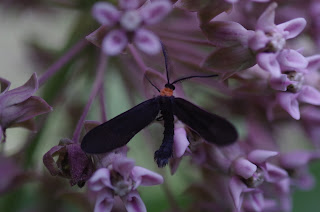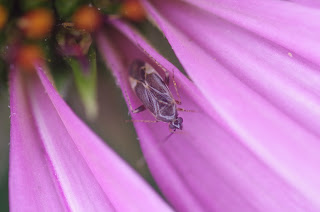Ailanthus webworm moth. This totally made my day. Unfortunately, this is the only picture I got–it flew away immediately when I opened the container to get a better picture.
Backyard Bug of the Day:
Grape leaf skeletonizer moth. I think that name is a reference to the eating habits of the caterpillar of this moth, that they eat grape leaves, but leave the "skeleton" of the leaf's veins behind I think this is a female, based on the antennae. More on that anon.
I found it feeding on the sumac flowers.
Better look at the antennae. One of the ways to tell the difference between moths and butterflies is by looking at the antennae: the moth's antennae are feathery, whereas the butterfly's are thin with a bit of a knob on the end. In general the male's antennae are bigger and featherier than the female's. So, here's the first grape leaf skeletonizer moth I found today...
... and here's the second, on milkweed. Note that these antennae are a bit wider. Also note that the body shape of the two is a little different, with the female (I think) having a wider body.
Also on the sumac:
Sweat bee
Some of the clumps of sumac flowers are past blooming, so the remaining clumps are getting pretty crowded. Under the circumstances, I think the insects feeding on this plant get along pretty well, given that they are competing for a wildly popular and daily diminishing food source. There are occasional skirmishes, and sometimes some insects are chased away, but you get quite a few insects feeding together here. Bonus points if you can spot the plume moth.
Ah, the first ambush bug I have seen this year! And here comes a big beetle!
I was very curious to see if the ambush bug would attack the beetle, but even though the beetle ultimately walked right over the ambush bug, there was no attack.
Sharpshooter
Stilt-legged bug
There are no insects to see here... as far as I can tell. I am puzzled as to why these flowers in full bloom are not covered in insects.
Just this one beetle.
Plant bug, and can you see the thrips as well?
Katydid. Still developing its wings.
Arachnid Appreciation:
.
.
.
.
.
.
.
.
.
.
.
.
Flower crab spider with thick-headed fly for dinner. And impressive catch with that size difference.
Six-spotted orb weaver



















No comments:
Post a Comment